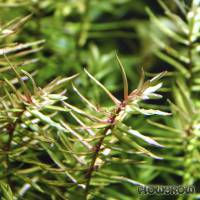



Didiplis diandra (De Candolle) Wood, also known as Peplis diandra, originates from the east of the USA, where it can be found on the edges of ponds, lakes and on slow-flowing waterbodies. It is considered endangered in some states. When kept under optimal conditions, it forms small pinkish pods in its axils. Its one-of-a-kind fine foliage makes it a very popular and rather widely spread aquarium plant.
All in all it is not difficult to cultivate, however, it has some requirements that ought to be met to make sure it grows well. There should be sufficient light, i.e. 0.6 - 1 watt per litre. Under less light, the lower parts of the plants tend to die off and rot away. However, please keep in mind that under more intensive light the plant will also need more iron and micronutrients. Faded, pale plants are a sure sign that Didiplis diandra suffers from an iron deficit. It is not absolutely necessary to add CO2, however, fertilising with CO2 results in considerably faster and healthier growth. Nitrate, phosphate and potassium have to be added in regular intervals, as well as iron and micronutrients, which Didiplis diandra craves. When kept in optimal conditions and under lots of light, Didiplis diandra shows colours from orange to red hues. Under less light, the plant tends to stay green.
This stem plant grows up to the water surface, where it throws many lateral shoots and grows very dense. To further a bushy look, just cut off the top shoot, which results in many new lateral shoots. Propagation is very easy, just cut off top and lateral shoots and replant into the substrate.
Didiplis diandra is used in Dutch as well as in nature aquaria as a colour and, due to its highly special leaf form, as a structural accent. It is best planted in the middle- or in the background.
<a href="https://www.flowgrow.de/db/aquaticplants/didiplis-diandra" target="_blank"><img alt="Didiplis diandra" title="Didiplis diandra" src="https://www.flowgrow.de/db/widget/aquaticplants/didiplis-diandra" /></a>
[url=https://www.flowgrow.de/db/aquaticplants/didiplis-diandra][img]https://www.flowgrow.de/db/widget/aquaticplants/didiplis-diandra[/img][/url]
[widget=aquaticplants/didiplis-diandra]Didiplis diandra[/widget]